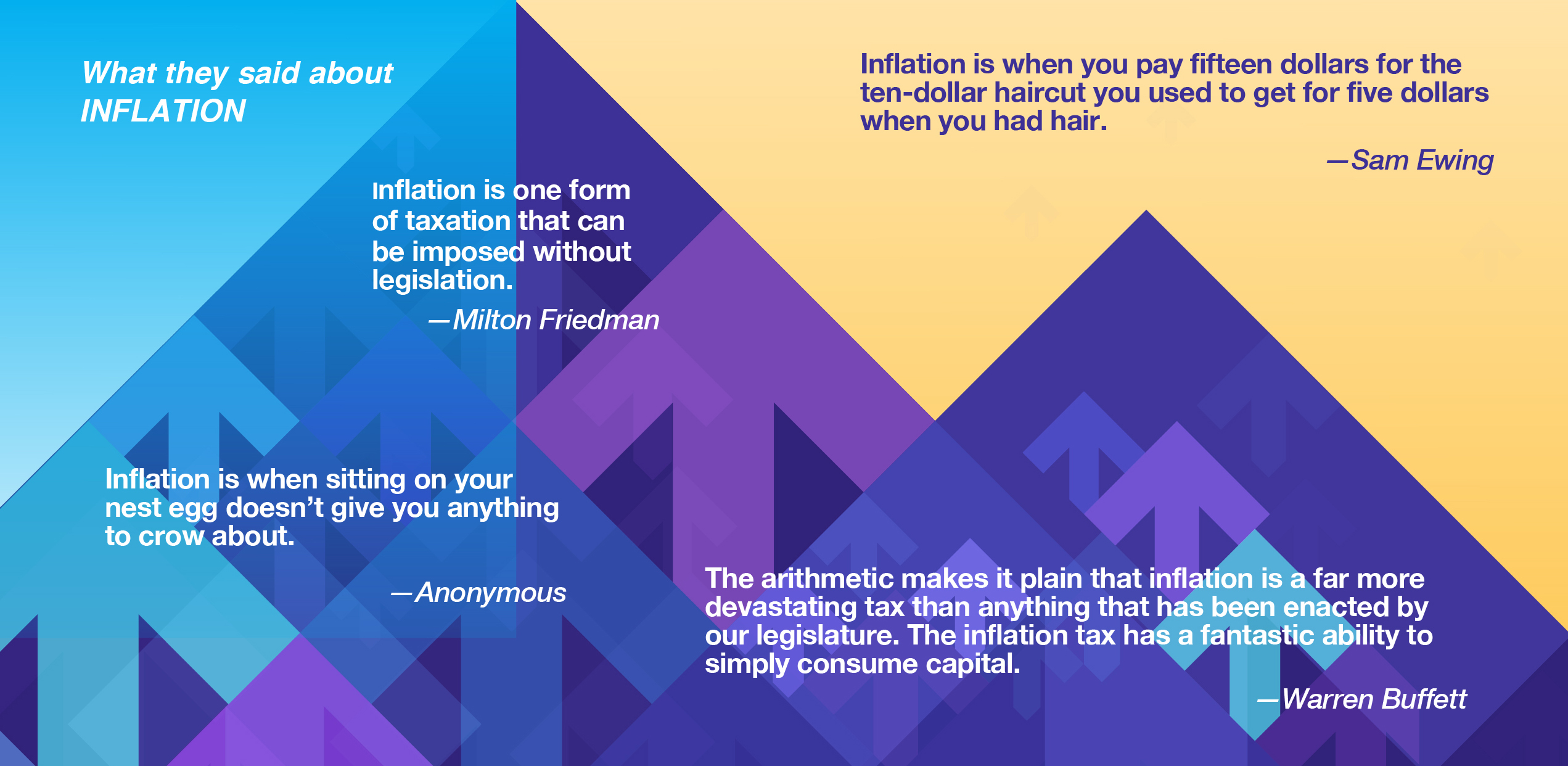October 1, 2022
The July news from the Department of Labor was sobering. The consumer price index for the 12 months ending in June 2022 rose by 9.1%, the largest such increase in over 40 years. Inflation has become widespread, across the entire economy.
- The 10.4% increase in food prices was the largest since February 1981.
- A 59.9% increase in gasoline prices was the largest since March 1980.
- Overall energy prices rose 41.6%, the largest since April 1980, including a 70.4% boost to home heating oil which consumers have not yet felt—but they will if it is a cold winter.
Wages have advanced as the pandemic has eased, but inflation has grown even faster. Real average hourly earnings have fallen 3.6% in the last twelve months, The Wall Street Journal reports, and average weekly earnings are down 4.4% because there has been a reduction of hours in the average workweek.
Hypothetical retirees.
When Sam and Janet retired in January 2010 their household expenses ran to $50,000 per year. Using the inflation calculator provided by the Department of Labor (https:// www.bls.gov/data/inflation_calculator.htm), ten years later they needed $59,526 to have the same buying power. By June of 2022, they would need $68,373. In other words, they’ve experienced almost as much inflation in the last two years as in the first ten of their retirement!
Past as prologue
In 1980 and 1981, the last time inflation was this serious, Paul Volcker was Chairman of the Federal Reserve. In March 1980, the federal funds interest rate at which banks lent to each other was 19.85%, according to the St. Louis Federal Reserve Bank economic data. In February 1981 it was 15.53%, down from the 22.0% reached in December 1980.
As of the end of June 2022, the federal funds rate was only 1.58%. Many additional interest rate hikes seem likely, given this history.
Investors have difficult choices. As interest rates rise, the value of existing bonds falls—that’s not investor sentiment, it’s just how the bond math works. Bonds with the longest maturities tend to fall the most. But stocks are not an easy alternative, as shown by the declines in the stock indices this year. Sam and Janet may have been protected from inflation during the first ten years of their retirement because, although there were down periods, on the whole the value of stocks rose more than inflation. Now, as inflation has taken off, the value of stocks is down at the worst possible moment.
Fear of recession is one factor that is depressing stock prices. Those high interest rates of the Volcker years triggered two recessions in quick succession—those downturns were the price for taming sustained inflation.
CPI-linked returns
Since 1997 the U.S. government has provided investors with a convenient tool for building inflation protection into their portfolios. That tool is Treasury Inflation-Protected Securities, or TIPS. These securities are issued several times during the year in maturities of five, 10 and 20 years. The principal value of the TIPS is adjusted annually for inflation, and that, in turn, affects the interest payments. (See “TIPS explained” at right for more on the mechanics of these securities.)
The coupon payments from TIPS are subject to ordinary income tax. One of the drawbacks of TIPS is that the principal adjustment is subject to ordinary income tax as well, in
the year that it is made, though there is no cash distribution to draw the tax payment from. For example, if the value of a $10,000 bond is raised to $10,250 to account for 2.5% inflation, that $250 adjustment is fully taxable. Because this situation can create a cash flow problem for meeting the tax obligation, often TIPS are recommended for tax-deferred accounts, such as IRAs.
In the event of deflation, the value of TIPS will decline. However, the redemption will be at face value, and the dividend can’t fall below zero, so there is a deflation hedge built in as well.
TIPS are traded on the secondary market. Their price fluctuates with changes in interest rates as well as changes in the inflation rate. Such volatility indicates that they are best suited for longer-term time horizons, reinforcing the idea that they are a good choice for IRAs.

TIPS explained
Assume that a TIPS is purchased with a face value of $10,000 and a dividend rate set at 2%. Assume as well, for the sake of this illustration, that inflation runs at a constant 2.5% annual rate. Finally, assume that the 2% dividend is paid in two coupons each year, of 1% each.
The first coupon would pay $100 (half of the 2% dividend times the $10,000 face value).
After a year the value of the bond would rise to $10,250, given the 2.5% inflation adjustment. Accordingly, the interest payment would rise to $102.50.
After ten years of 2.5% inflation, the value of the bond would rise to $12,800, bringing the coupon payment to $128.
However, if there is one thing that we know for certain, it is that inflation will not stay at a constant rate for ten years.
This example is for illustrative purposes only, and the return is not indicative of any actual investment. Actual investments may differ substantially.
Some investment funds include TIPS among their holdings, and some funds specialize in TIPS. Funds can provide for diversification of maturities and easy rein- vestment choices. On the other hand, funds do not have a maturity date, and so can present risks not present when TIPS are owned outright.
Can we tell you more?
TIPS are not the only inflation-fighter to consider for one’s portfolio. Dividend-paying stocks or commodities are alternatives favored by some investors, for example.
If you would like a second opinion about your portfolio management strategies, we would be pleased to share our expertise with you. Just call on us!




